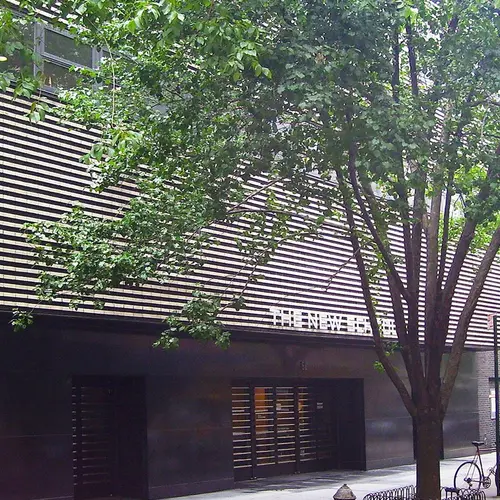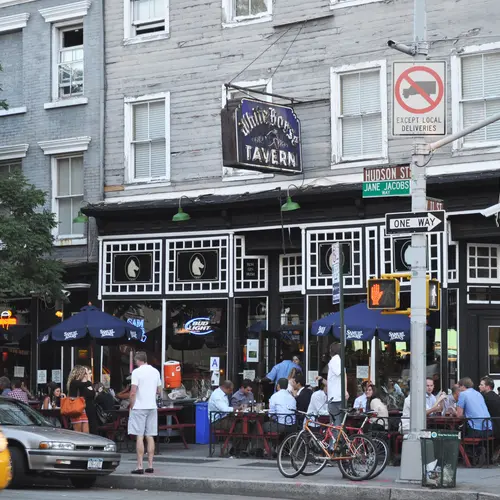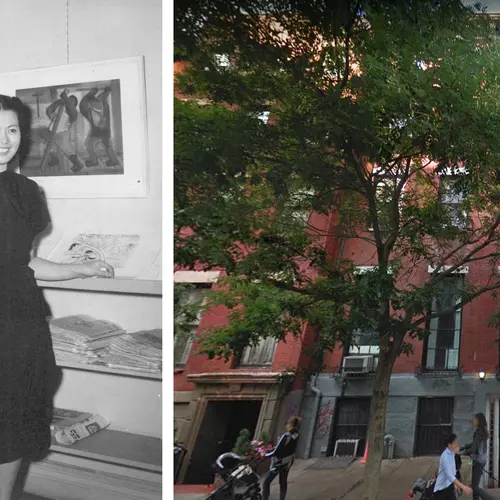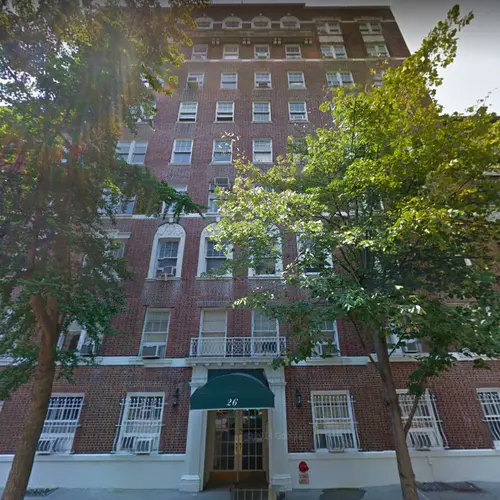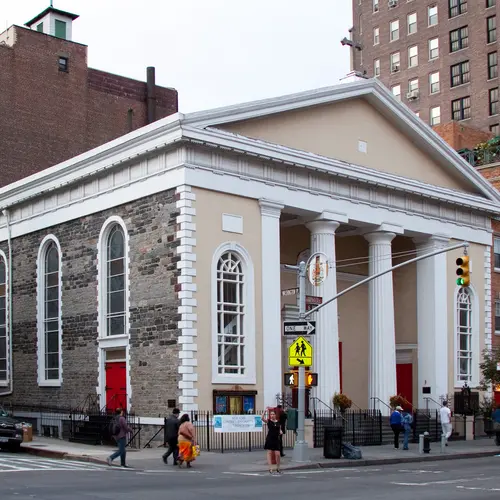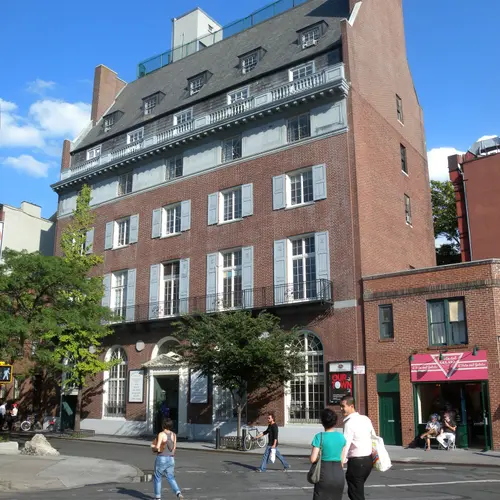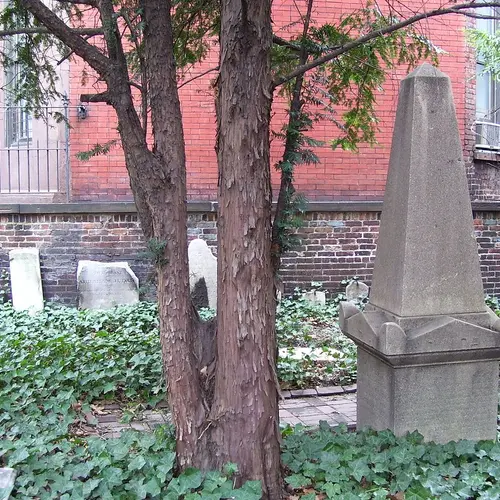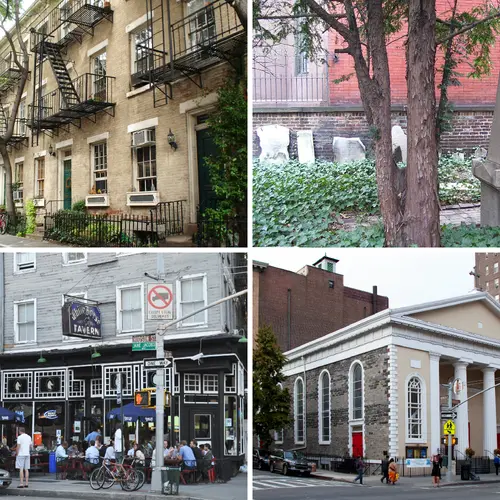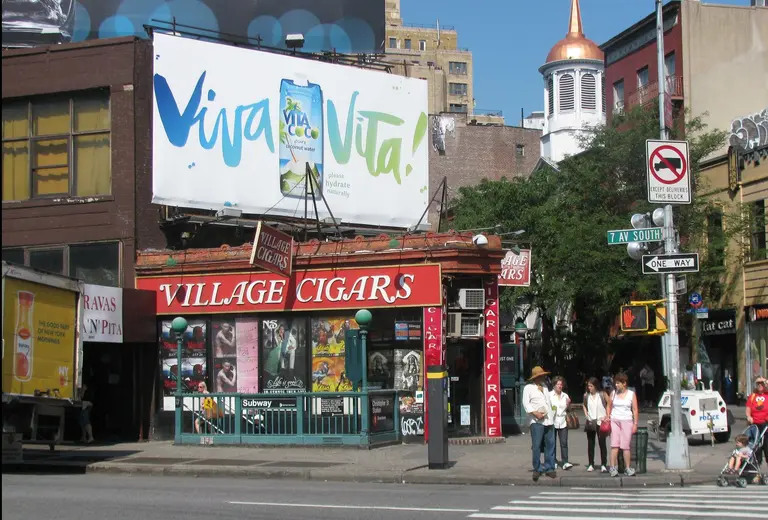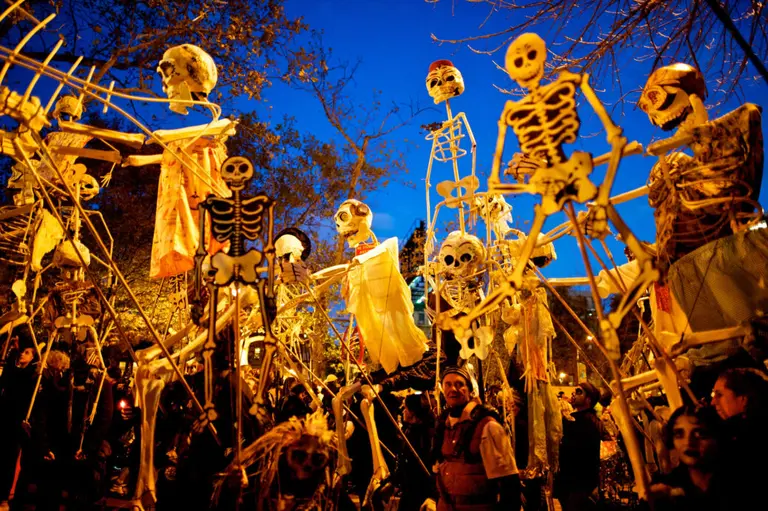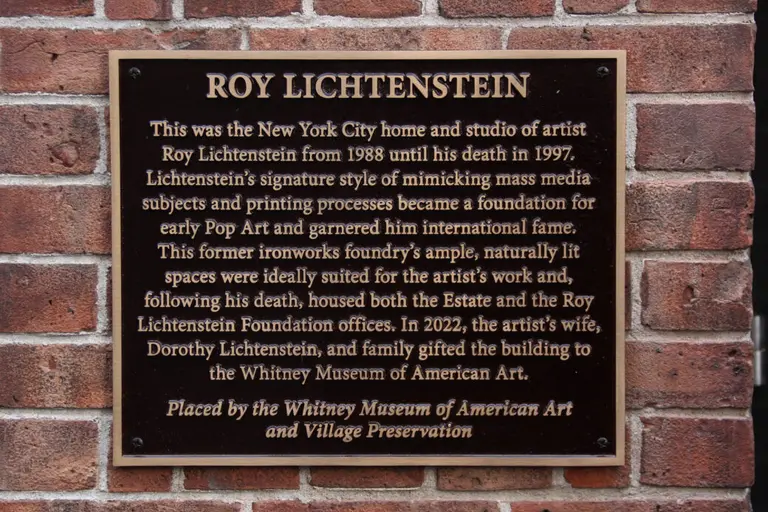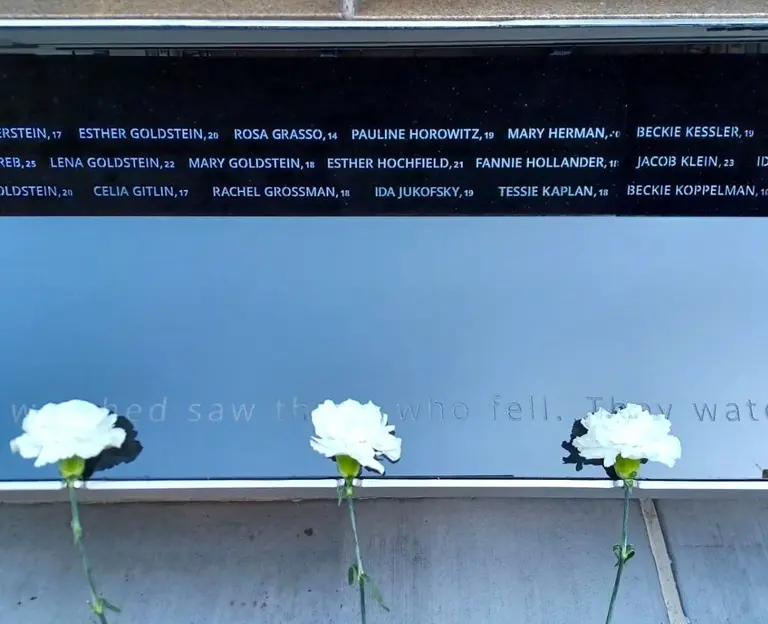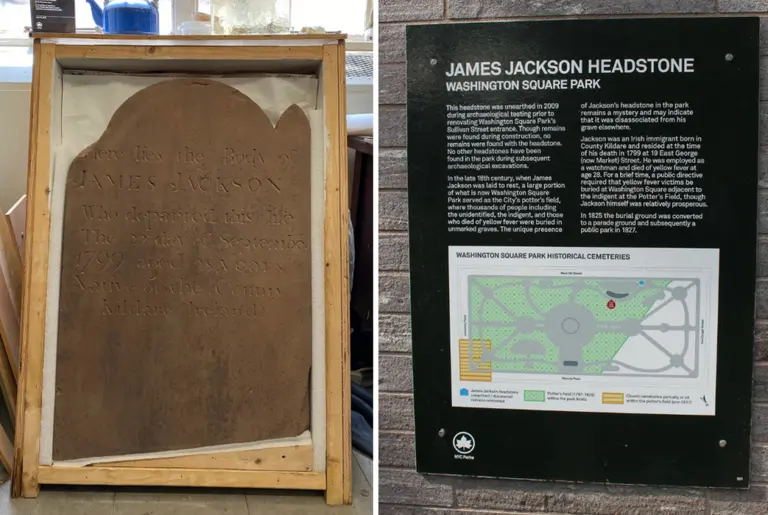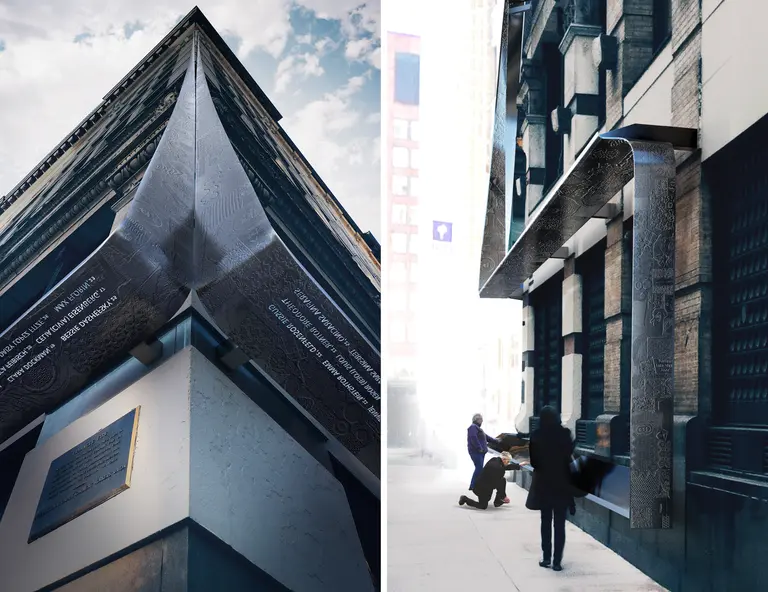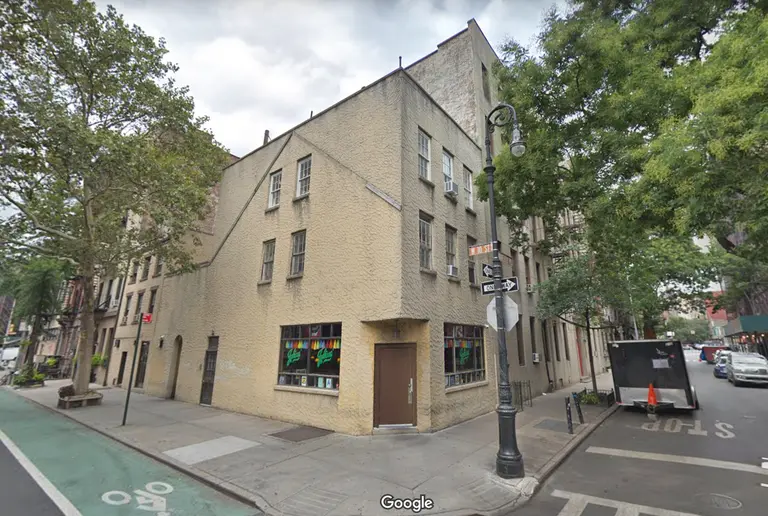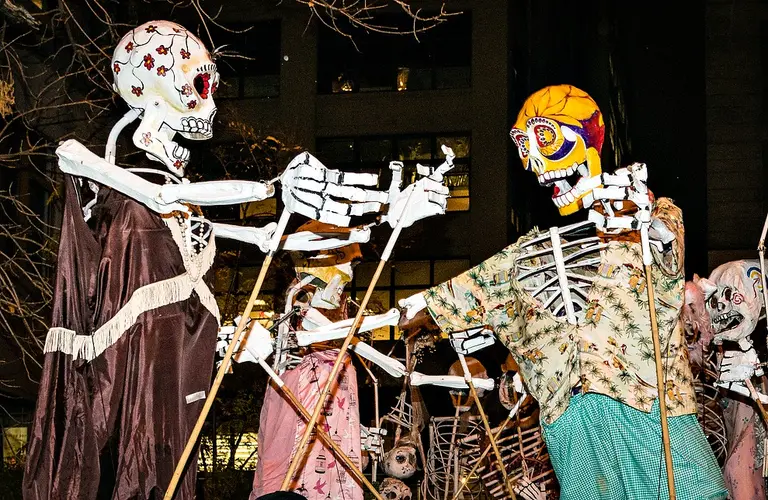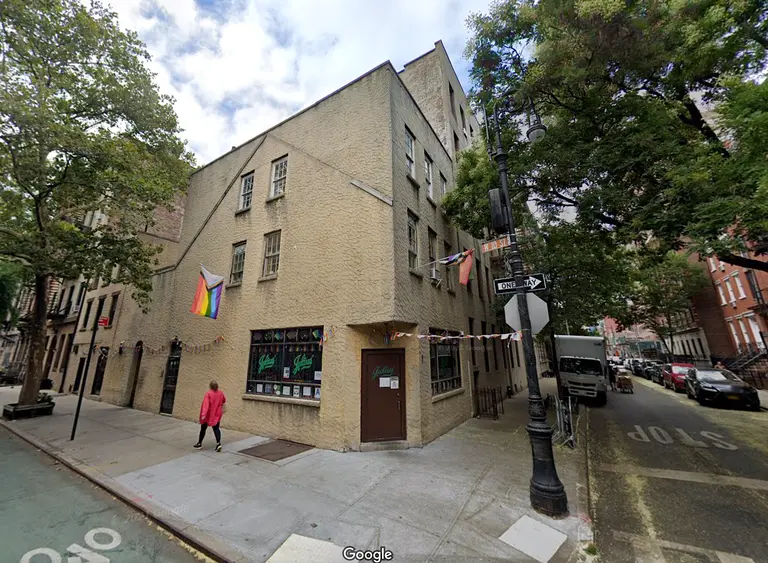11 landmarks of immigration in Greenwich Village

This year marks the 50th anniversary of the designation of the Greenwich Village Historic District. One of the city’s oldest and largest landmark districts, it’s a treasure trove of history, culture, and architecture. Village Preservation is spending 2019 marking this anniversary with events, lectures, and new interactive online resources. This is part of a series of posts about the Greenwich Village Historic District marking its golden anniversary.
Each year, immigrant history week is celebrated in late April, commemorating the day in 1907 when more immigrants came through Ellis Island than any other day in history. More than a few of those immigrants came through Greenwich Village, which has a long and storied history of welcoming newcomers from across the city, country, and globe. Here are just a few of the sites within the Greenwich Village Historic District where landmarks of our nation’s rich and varied immigrant history can be found, from the oldest surviving Jewish cemetery in the country to a hub of “Little Spain.”
1. Second Cemetery of the Spanish and Portuguese Synagogue, 72 West 11th Street
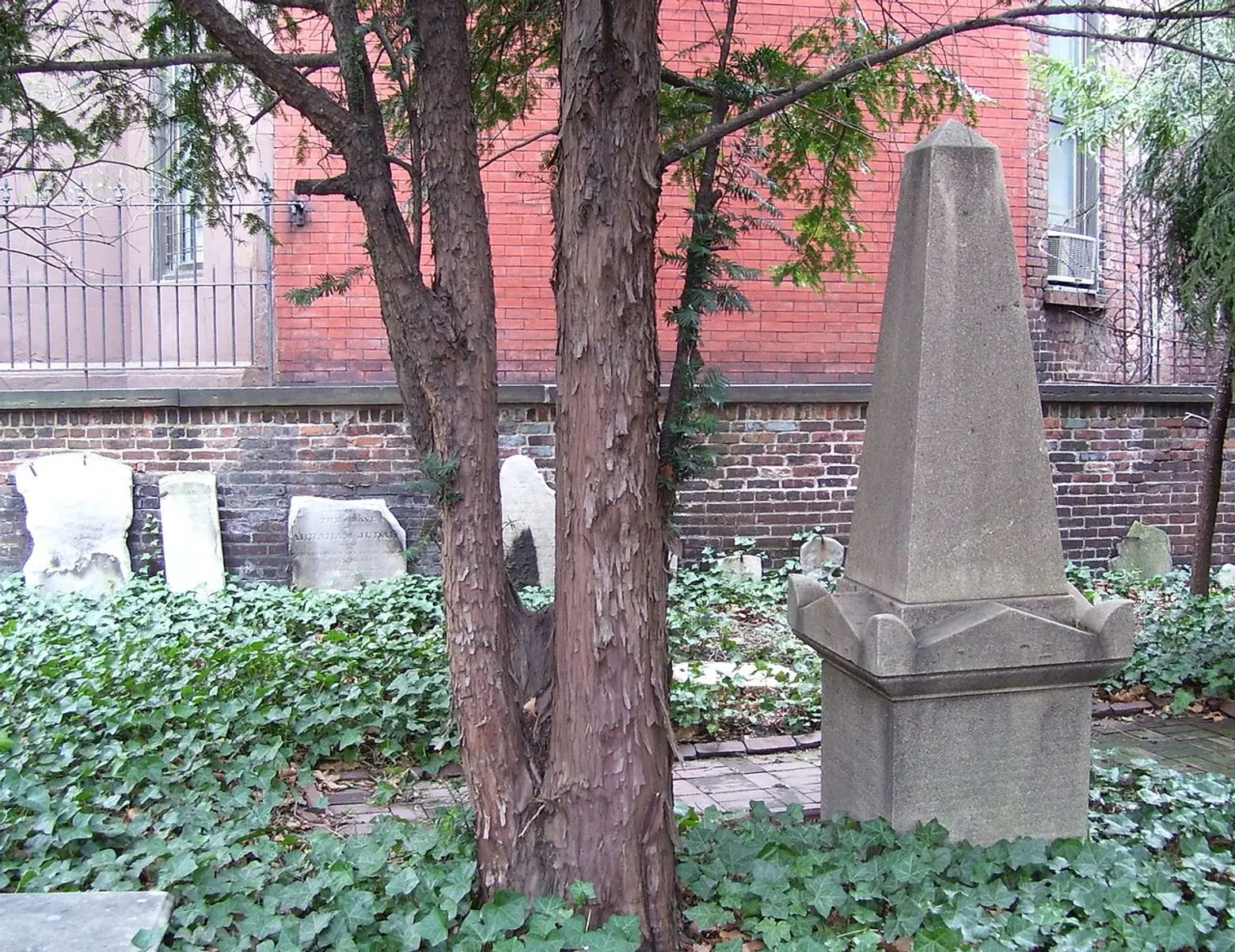 Via Wiki Commons
Via Wiki Commons
In 1492, Spain ordered all Jews living within the kingdom to either convert to Christianity or be expelled. Portugal did the same less than five years later. Some of those Jews converted and remained in Spain or Portugal, either secretly practicing their faith or genuinely converting (even some of those, however, continued to face persecution). Many more, however, fled to North Africa and the Ottoman Empire, Holland, and eventually the New World. Some of these Sephardic Jews (Jews with roots in the Iberian peninsula who spoke Ladino, a cross between Hebrew and medieval Spanish and Portuguese), eventually ended up in New York, becoming the first Jewish settlers of our city, long before the flood of Ashkenazi Jews in the late 19th and early 20th century (Jews with roots in Germany who settled in Eastern Europe after their expulsion from the German lands, and who spoke Yiddish — a cross between Hebrew and medieval German), who form by far the majority of New York’s and America’s Jewish population.
The evidence of these pioneering Spanish and Portuguese Jews can still be seen in Greenwich Village in the Second Spanish & Portuguese Shearith Israel Cemetery on West 11th Street, just east of 6th Avenue. Shearith Israel was the only Jewish congregation in New York City from 1654 until 1825, during which time all of the practicing Jews of New York belonged to this single congregation. It was founded by 23 Jews, mostly of Spanish and Portuguese origin. The earliest Jewish cemetery in the U.S. was recorded in 1656 in New Amsterdam when authorities granted the Shearith Israel Congregation “a little hook of land situated outside of this city for a burial place.” Its exact location is unknown. The Congregation’s “second” cemetery, which is today known as the First cemetery because it is the oldest surviving one, was purchased in 1683.
That “First” Cemetery of the Spanish-Portuguese Synagogue, Shearith Israel was established in 1683 at 55-57 St. James Place in Lower Manhattan. In 1805, when that cemetery was filled to capacity, the “Second” Cemetery plot was purchased and established on a much larger plot in then-rural Greenwich Village, to which some of the bodies from the First cemetery were moved. The Second Cemetery on 11th Street operated until 1829; during that time the establishment of the Manhattan street grid cut 11th Street through the cemetery, dislodging most of it (many of those bodies were moved to the “Third” cemetery, which still exists on West 21st Street).
What remains today on West 11th Street is a small triangular section of the much larger, original cemetery, still owned and maintained by the Shearith Israel congregation, now located on the Upper West Side.
2. Monument to Giuseppe Garibaldi, Washington Square
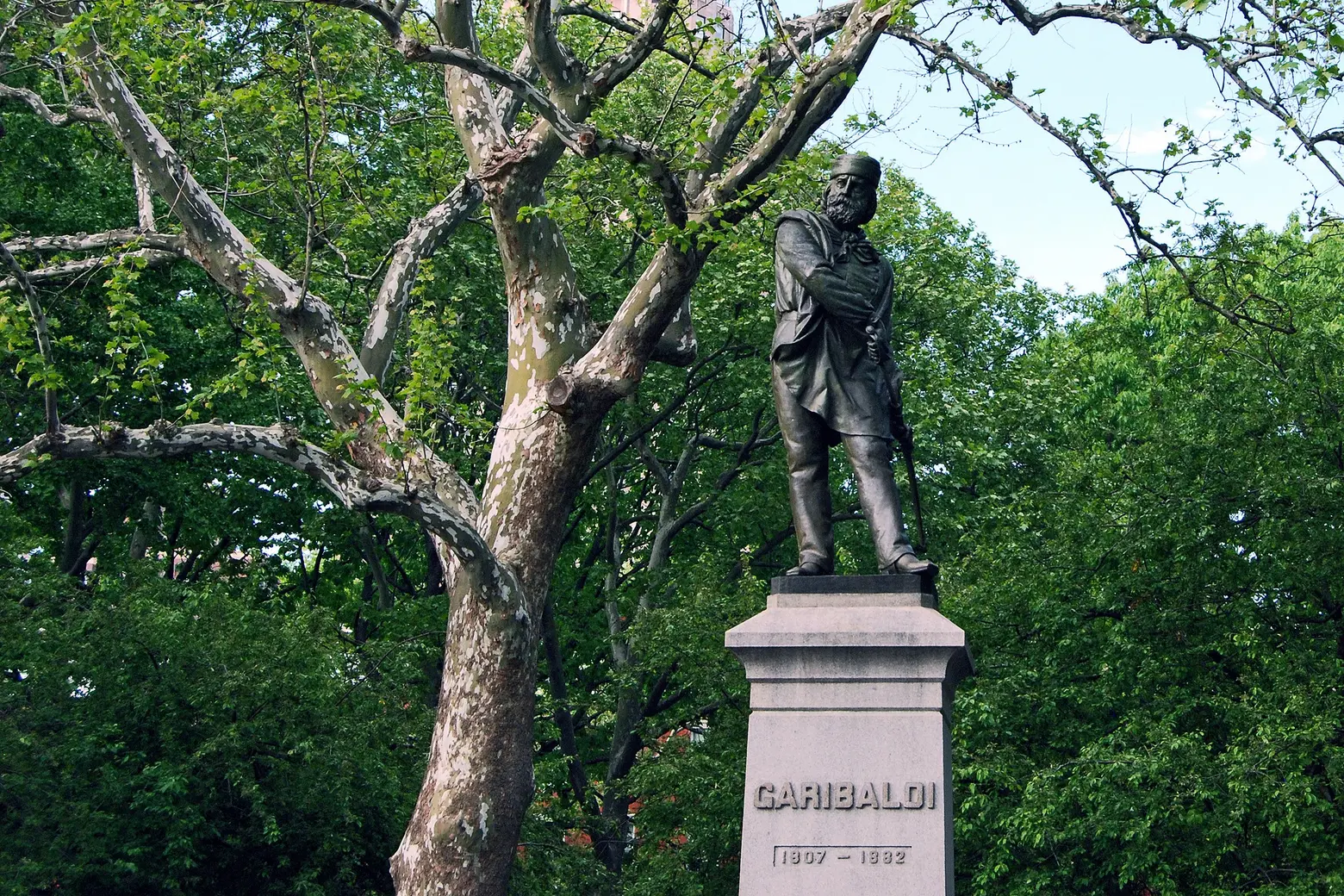 Via Flickr cc
Via Flickr cc
This bronze and granite monument to “the Father of Modern Italy” was dedicated in 1888, just eight years after Garibaldi’s death. The statue and pedestal were commissioned and paid for by Italian immigrants from the area who began the campaign to erect the monument almost immediately after Garibaldi’s passing, speaking to the breadth and influence of this community as early as the 1880s, which only grew in size and stature over the following decades.
Garibaldi was considered one of the greatest military minds of the 19th century, and he led many of the successful campaigns which resulted in the unification of Italy in 1870. Garibaldi was a Republican and progressive social thinker in many respects; after Italian unification, he served in the parliament, where he also founded the League of Democracy and advocated for universal suffrage, the emancipation of women, and limits on the power and influence of the church.
From the late 19th through the early 20th centuries, Greenwich Village had, along with nearby Little Italy and East Harlem, the largest Italian immigrant community in New York.
3. The New School for Social Research’s “University in Exile,” 66 West 12th Street
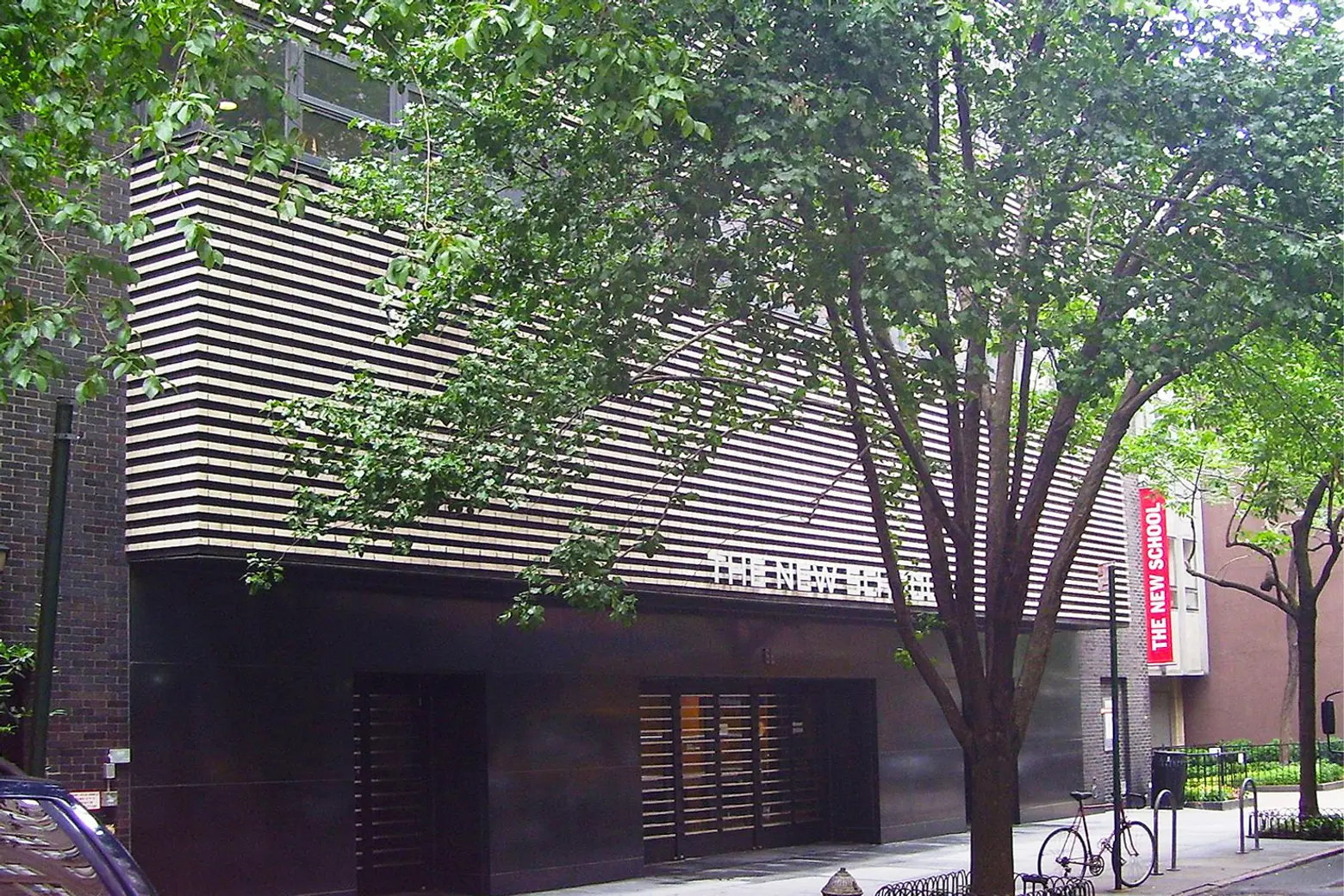 Via Wiki Commons
Via Wiki Commons
The New School was founded in 1919 by progressive intellectuals “looking for a new, more relevant model of education, one in which faculty and students would be free to honestly and directly address the problems facing societies.” But one of the most critical chapters in the school’s hundred-year history came in 1933 when it helped draw and save intellectuals fleeing Nazi persecution, transforming and vastly expanding American academia and intelligentsia.
When Hitler came to power in 1933, he began to purge Jews and politically hostile elements from German universities. With the financial support of philanthropist Hiram Halle and the Rockefeller Foundation, The New School obtained funding to provide a haven in the United States for scholars whose lives and careers were threatened by the Nazis.
Called “the University in Exile,” the school sponsored more than 180 individuals and their families, providing them with visas and jobs. Some remained at The New School for many years, while others moved on to other institutions in the United States. But the influx of some of the greatest minds and talents of the era had a far-reaching impact, helping to turn the United States into the intellectual and academic powerhouse it became in the post-War years.
The University in Exile helped transform the social sciences and philosophy in this country, presenting new theoretical and methodological approaches to their fields. Some of those scholars have included economists Adolph Lowe and Robert Heilbroner, political scientists Arnold Brecht and Aristide Zolberg, sociologists Emil Lederer and Peter Berger, psychologists Max Wertheimer and Jerome Bruner, historian Charles Tilly, and philosophers Hannah Arendt, Leo Strauss, and Reiner Schürmann.
4. Greenwich House, 27 Barrow Street
 Via Wiki Commons
Via Wiki Commons
One of New York’s oldest and largest “Settlement Houses,” Greenwich House was established in 1902 to aid and support recent immigrants to this country. Social reformers Mary Simkhovitch, Jacob Riis, and Carl Schurz helped found the institution at a time when this part of Greenwich Village was teeming with new immigrants. Simkhovitch and Greenwich House’s work led to the publication of the country’s first tenants manual and the founding of United Neighborhood Houses, which to this day remains an umbrella group for the several dozen settlement houses still operating in New York City.
By focusing on the arts and innovative approaches to education and enrichment, Simkhovitch was able to attract the participation and support of such notable figures as Eleanor Roosevelt, Gertrude Whitney, Daniel Chester French, John Sloan, and Jackson Pollock to Greenwich House (the Settlement House philosophy focused on bringing people of privilege and those in need together). Greenwich House accomplished many firsts for Settlement Houses, including establishing a nursery school in 1921, an after-school program in 1942, and a drug-free outpatient counseling center in 1963.
Simkhovitch eventually became the first Vice-Chairman of New York City’s Housing Authority, where she co-authored the National Housing Act of 1937. This law established the federal government’s responsibility to provide low-income housing, generating hundreds of thousands of units in the years that followed, housing many recent immigrants and other poor urban dwellers.
5. Patchin Place, off 10th Street between 6th Avenue and Greenwich Avenue, and “Little Spain”
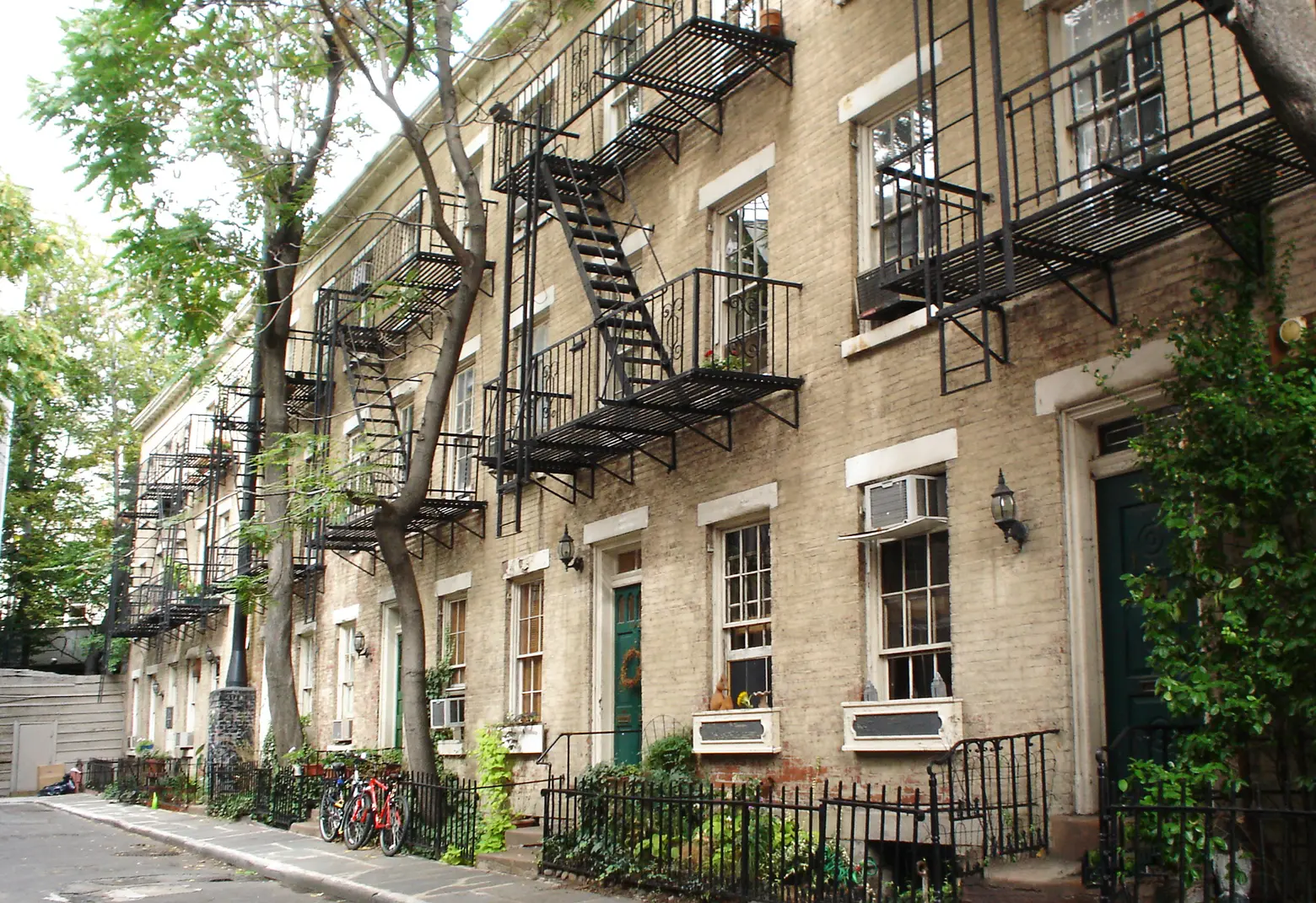 Patchin Place via Flickr cc
Patchin Place via Flickr cc
Patchin Place may be better known for its disarming charm, the bevy of literary and artistic figures who have lived there over the years, or the concentration of therapists’ offices located there in recent years. But a key part of its history is the immigrants who were the original occupants of these quaint cottages.
Long before poet ee cummings, journalists John Reed and Louise Bryant, authors Charles Platt and Theodore Dresier, artist Djuna Barnes, or actor Marlon Brando made Patchin Place their home, this gated cul-de-sac of 10 small three-story houses was built around 1849. While historical accounts differ, either the first or some of the earliest occupants of the houses seem to have been Basque waiters employed at the nearby Hotel Brevoort on Fifth Avenue (since demolished).
The West Village was once the heart of New York’s “Little Spain” neighborhood, a community of Spanish immigrants that stretched from Christopher Street to 23rd Street. Tangible remnants today of that once-thriving immigrant community in Greenwich Village include our Lady of Guadalupe Church and “La Nacional,” the Spanish Benevolent Society of New York, located on West 14th Street.
6. White Horse Tavern, 567 Hudson Street
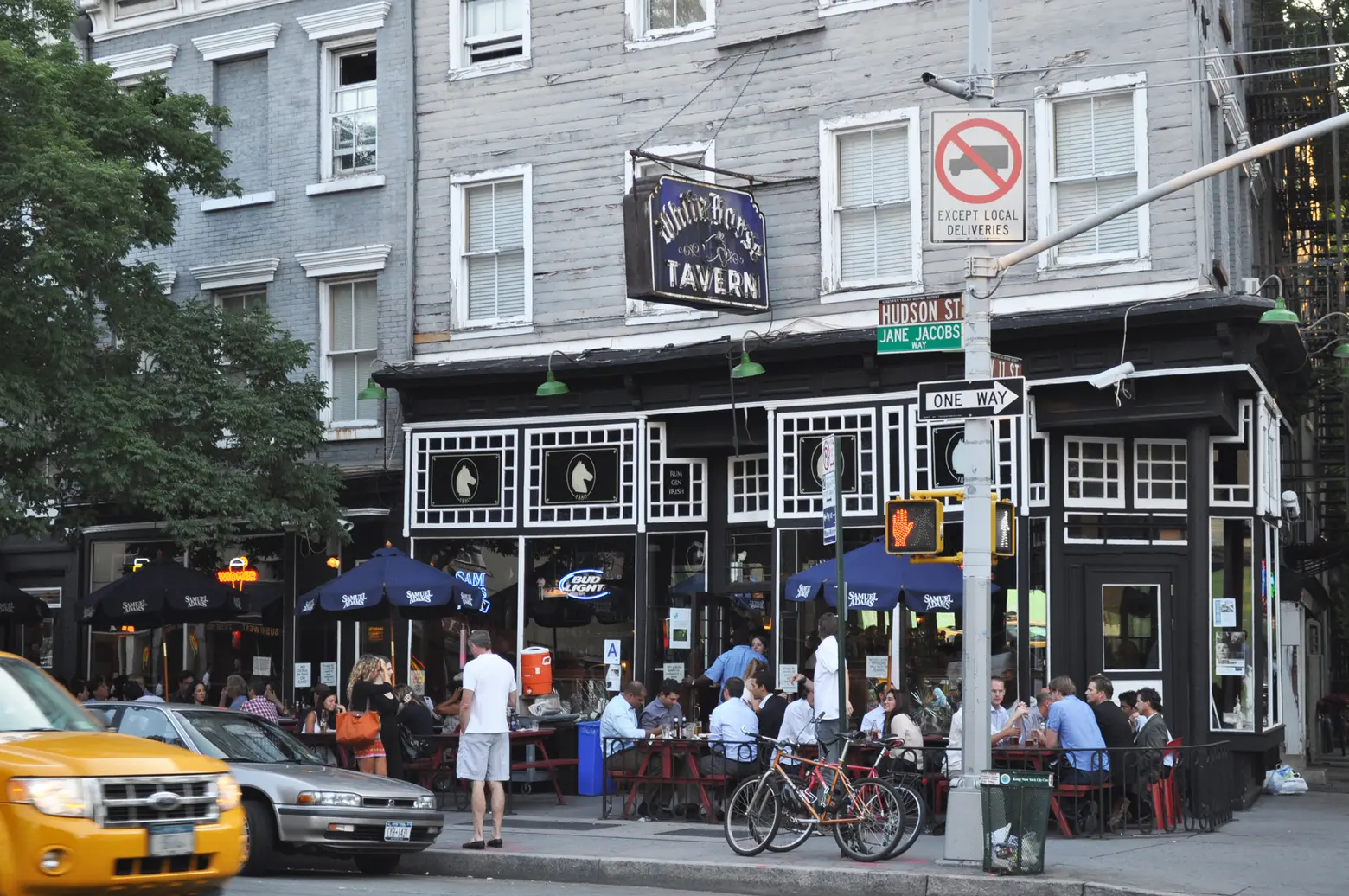 Via Flickr cc
Via Flickr cc
While perhaps most famous as a hang-out for the great literary minds of the mid-20th century, including Dylan Thomas, James Baldwin, Jane Jacobs, and Jack Kerouac, the White Horse was established as an Irish longshoremen’s bar in the 19th century, and gained fame in the late 19th and early 20th century as a center of left-wing Irish political organizing and thought.
In the late 19th century, 95 percent of the longshoremen working the very active Greenwich Village waterfront were Irish or of Irish descent. Much of the West Village was occupied by Irish immigrants or people of Irish extraction, who built churches, schools, social halls, and taverns in the neighborhood.
The White Horse was one such tavern, opened in 1880 by Whitey Munson. Located just three blocks from the waterfront, the Irish longshoreman clientele it attracted leaned increasingly leftward over the years, and the tavern became ground zero for union and communist organizing in the area. These Irish left-wing organizers created a safe space during the anti-Communist Red Scare of the 1950s, which then attracted left-leaning writers like one Welsh immigrant named Dylan Thomas. Thomas famously drank himself to death at the White Horse, while Jack Kerouac, the son of French-Canadian immigrants (his given name was Jean-Louis) was frequently thrown out of the White Horse for his unruly behavior.
7. Thirteenth Street Presbyterian Church, 141-145 West 13th Street, and the anti-immigrant fervor of the 1884 Presidential Election
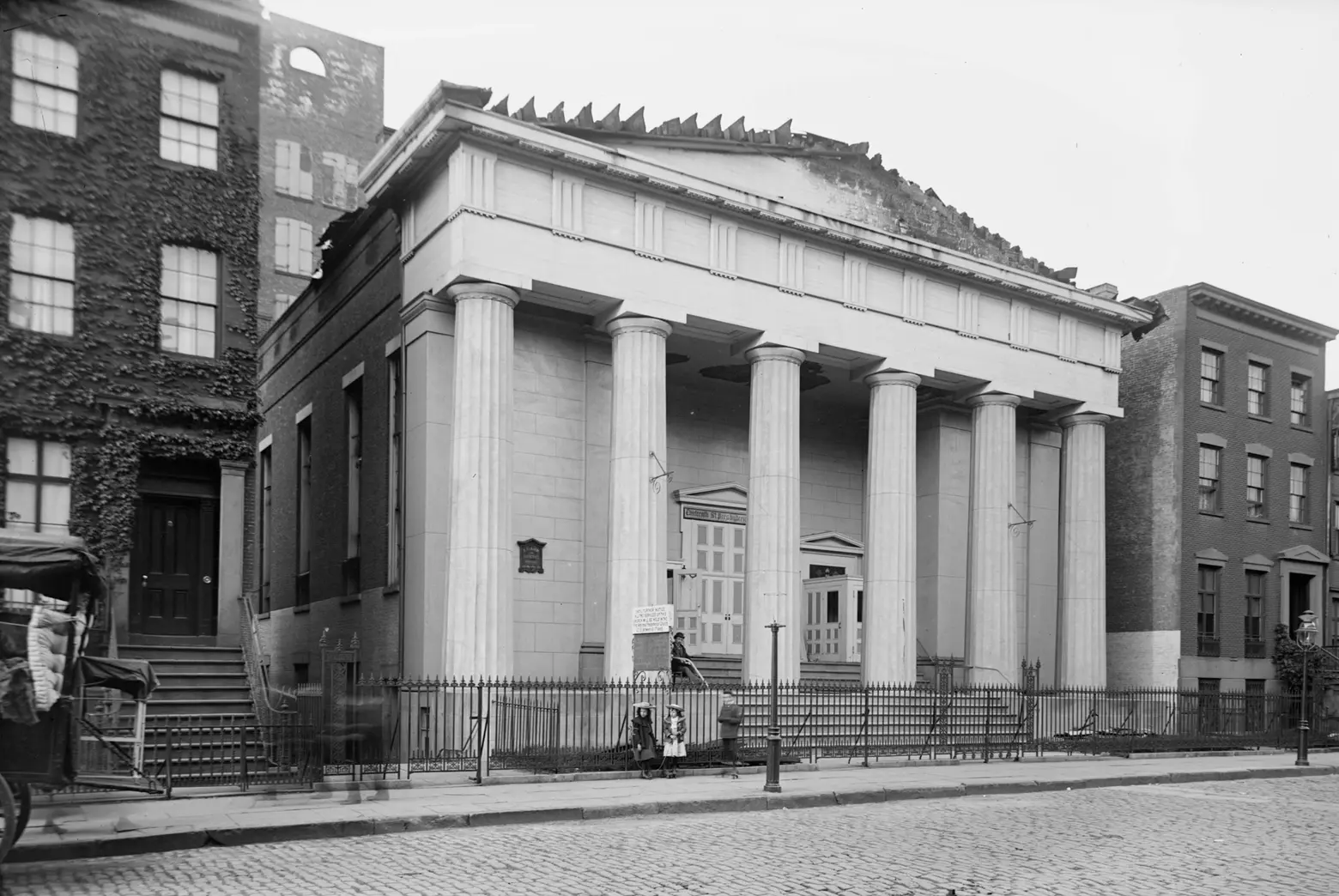 The Thirteenth Street Presbyterian Church in 1902, courtesy of the New-York Historical Society, Robert L. Bracklow Photograph Collection
The Thirteenth Street Presbyterian Church in 1902, courtesy of the New-York Historical Society, Robert L. Bracklow Photograph Collection
Greenwich Village may have a proud history of welcoming immigrants, but not all of the neighborhood’s residents was quite so willing to extend their open arms. In fact, one prominent Greenwich Village leader’s disdain for Catholic immigrants led to the coining of one of the most notorious slurs in American political history, and arguably changed the outcome of the hotly-contest Presidential election of 1884.
In 1884, Democrat Grover Cleveland was running for President against Republican James Blaine. Blaine was embroiled in a bribery and corruption scandal that resulted in many Republicans jumping ship and supporting Cleveland, presenting the possibility of the first Democrat to win the White House since the Civil War. But Republican loyalists pushed back, fanning the flames of a scandal which soon engulfed Cleveland – that he had apparently fathered a child out of wedlock. Seeking to rally their base against the Democratic insurgent, Republicans led by the Rev. Samuel Burchard, leader of the 13th Street Presbyterian Church, gathered before the election to sound the alarm against a potential Democratic victory, warning loyalists not to support the party (in Burchard’s words) of “rum, romanism, and rebellion,” citing the party’s large constituency of Southern former Confederates and northern Catholics (who were thought to be particularly fond of drink).
A Democratic spy at the rally reported the insulting alliteration to the press, which painted Blaine as anti-Catholic. In one of the closest Presidential elections in history, Cleveland won the electoral college by just barely winning New York State’s 36 electoral votes by a mere 1,000 votes cast or 0.1 percent. His edge came from high levels of support in heavily Catholic New York City, whereas he lost to Blaine in predominantly-Protestant Upstate New York. Cleveland would be the only Democrat elected to the White House between 1860 and 1912.
8. St. Joseph’s Church, 371 6th Avenue
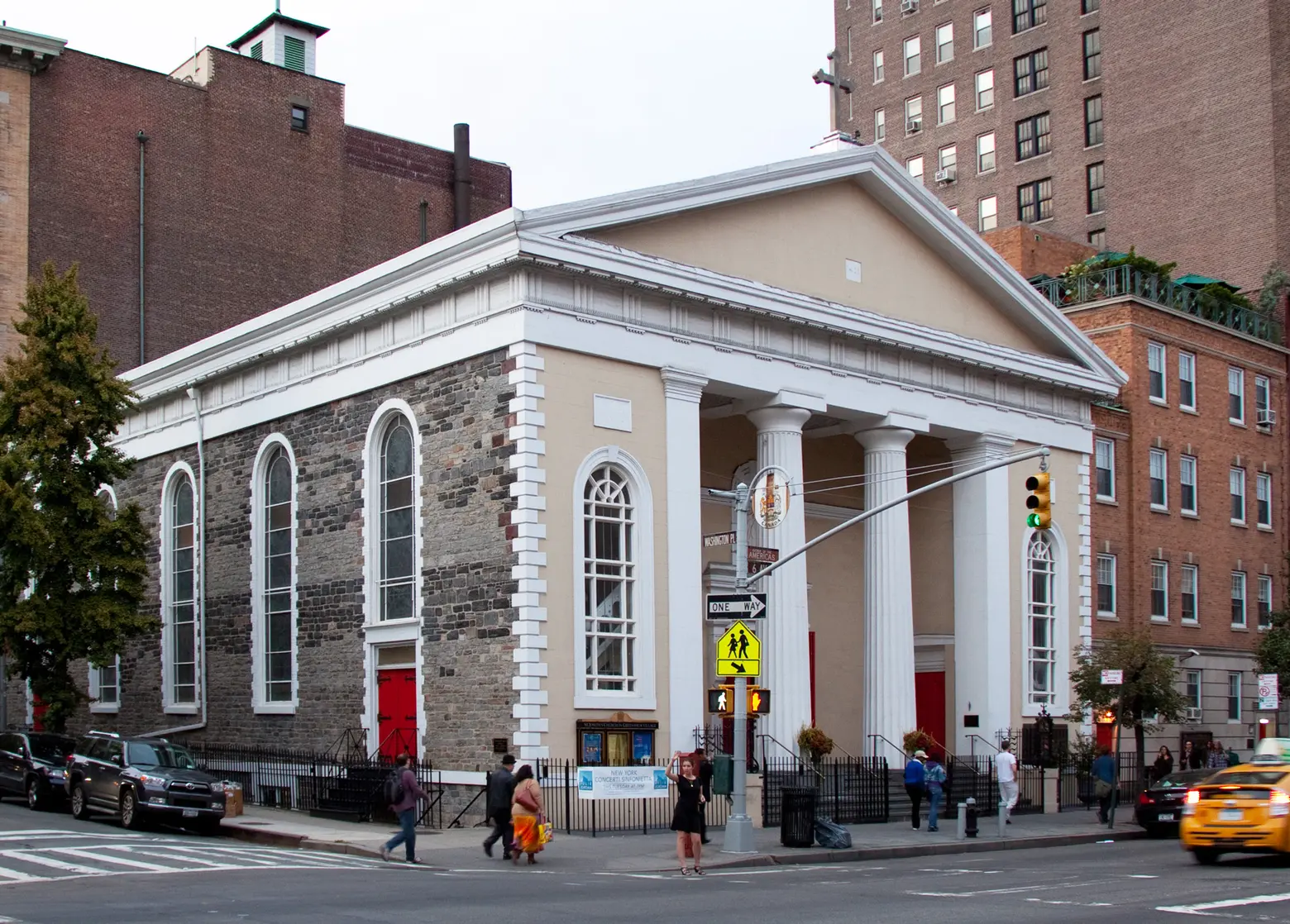 Via Flickr cc
Via Flickr cc
Opened in 1834, St. Joseph’s is the oldest Catholic church building in Manhattan (other older Catholic church buildings were either demolished or burnt down and rebuilt at later dates). The church was built largely to accommodate the expanding population of Irish immigrants coming to the area in the 19th century, though German and French immigrants were also numerous in the neighborhood.
The church’s founding is credited to the first Irish who settled in Greenwich Village. These first residents largely came to serve as domestic servants or to work on the construction of buildings. Greenwich Village’s population rapidly expanded in the late 18th and early 19th centuries following outbreaks of yellow fever and cholera in Lower Manhattan in 1799, 1803, 1805, and 1821. Those who could, fled to the healthier “Village” of Greenwich just to the north, and these laborers and servants followed them.
The parish originally served an area from Canal Street to 20th Street and was the sixth Catholic parish established in New York City. The church has been known to welcome more than just immigrants; in 1982, it hosted the first meeting of what would become the Gay Officers Action League, an organization of LGBT police officers.
9. The Chinese Consulate and Mission, 26 West 9th Street
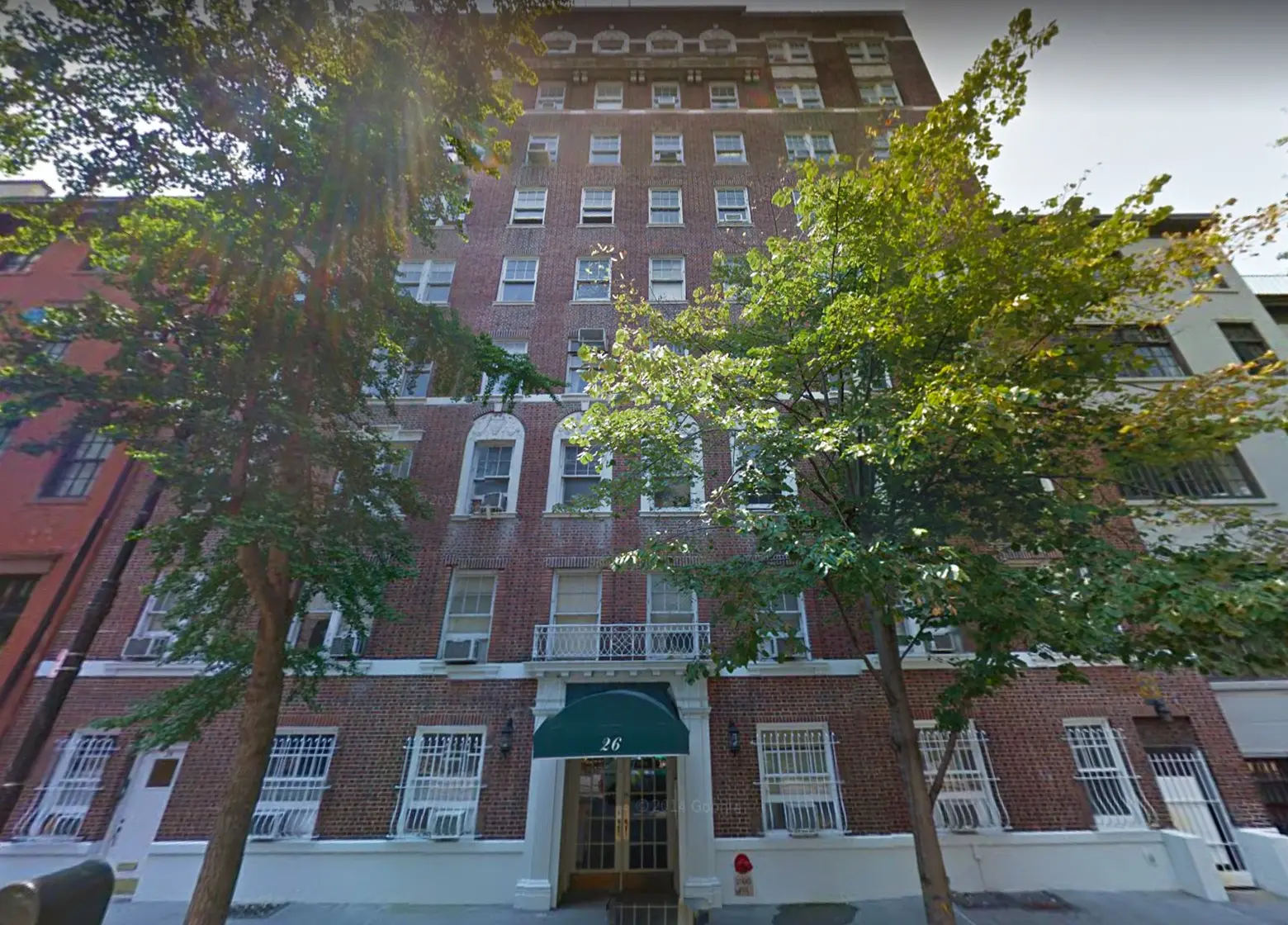 Google Street View of 26 West 9th Street today
Google Street View of 26 West 9th Street today
In the late 19th century, Chinese immigrants to the United States faced rampant discrimination and legal hurdles to gaining employment, housing, and citizenship. This was especially true in the American west, but New York was not free of such discrimination either.
In spite of this, many Chinese immigrants came to New York from China, the west, and Canada. While today’s Chinatown was the main hub of organizing and engagement to assist and protect Chinese immigrants, Greenwich Village at this time also served as a significant center of mobilization.
An important part of these efforts emanated from the Chinese Mission and Consulate, located at 26 West 9th Street. Here, lodging was provided to Chinese students who could not find rooms to rent elsewhere due to discriminatory practices, and Chinese immigrants were given legal assistance (the Jefferson Market Courthouse, which served much of the West Side of Manhattan, was just at the end of the block), help in seeking employment, and religious guidance. The building housing the Mission and Consulate was demolished in 1923, and replaced with the apartment building found there today.
10. Home of Emma Lazarus, author of “The New Colossus,” 18 West 10th Street
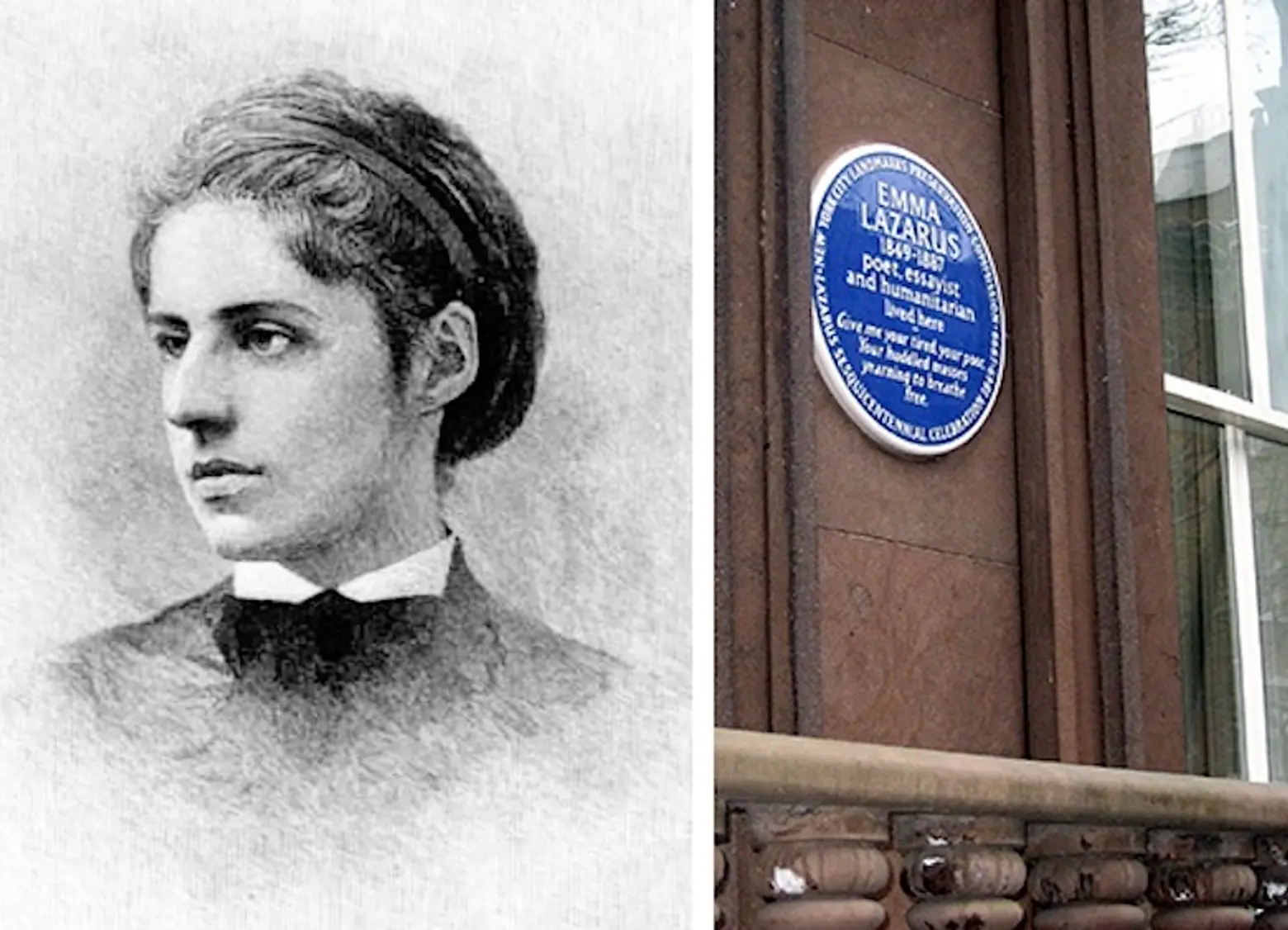 Emma Lazarus (L) via Wiki Commons; Plaque on her former home via Flickr cc
Emma Lazarus (L) via Wiki Commons; Plaque on her former home via Flickr cc
Though born into a prosperous family, Emma Lazarus (1849-1887) became an advocate for poor Jewish refugees and helped establish the Hebrew Technical Institute of New York to provide vocational training for destitute Jewish immigrants. As a result of anti-Semitic violence in Russia following the assassination of Tsar Alexander II in 1881, many Jews emigrated to New York, leading Lazarus, a descendant of German Jews, to write extensively on the subject.
In 1883 she wrote her best-known work, the poem “The New Colossus,” to raise funds for the construction of the Statue of Liberty. In 1903, more than 15 years after her death, a drive spearheaded by friends of Lazarus succeeded in getting a bronze plaque of the poem, now so strongly associated with the monument, placed on the pedestal of the Statue of Liberty. It includes the famous lines: “Give me your tired, your poor, Your huddled masses yearning to breathe free, The wretched refuse of your teeming shore. Send these, the homeless, tempest-tost to me, I lift my lamp beside the golden door!”
11. Miné Okubo Residence, 17 East 9th Street
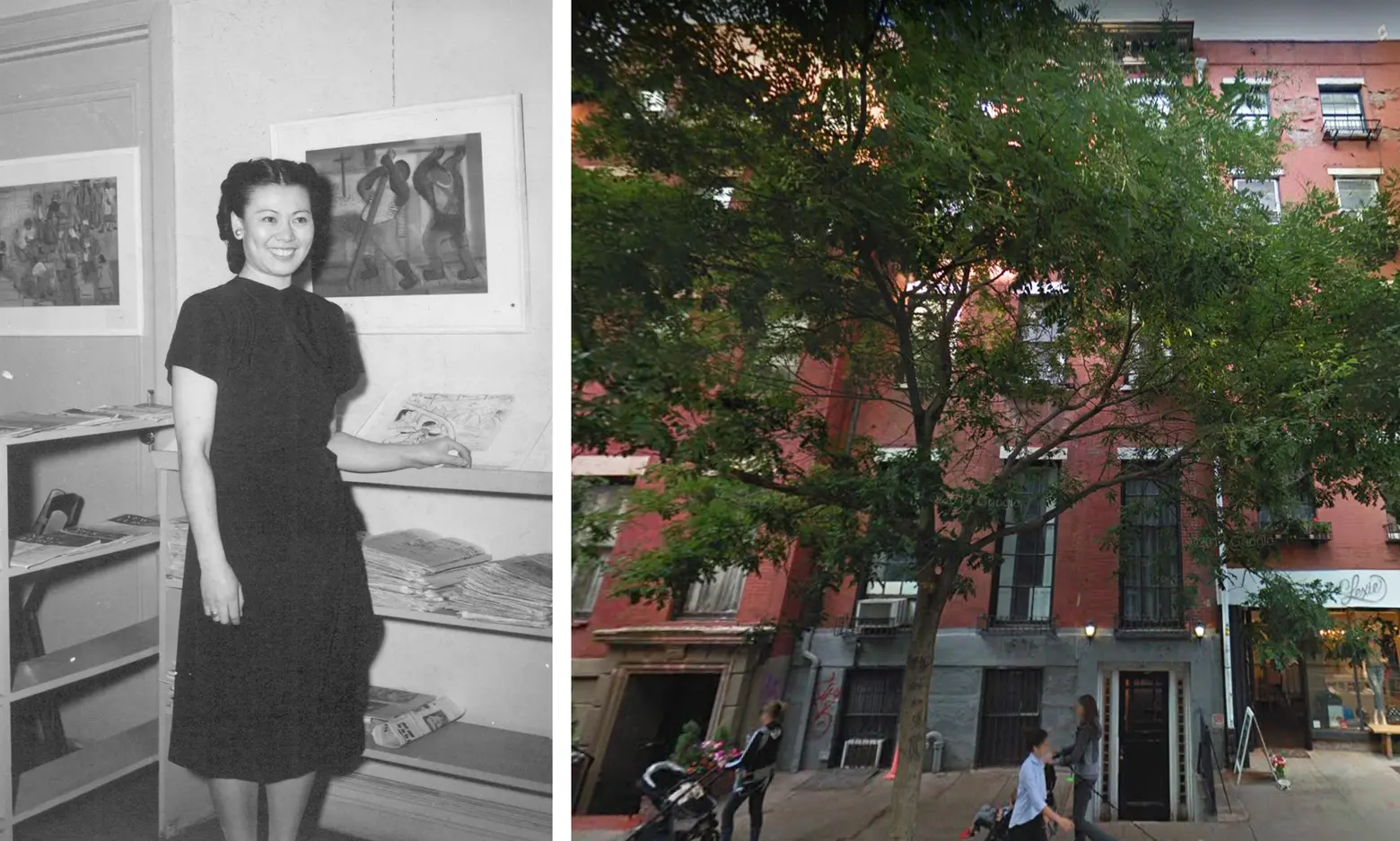 Miné Okubo (L) via Wiki Commons; 17 East 9th Street (R) via Google Street View
Miné Okubo (L) via Wiki Commons; 17 East 9th Street (R) via Google Street View
Though not an immigrant herself, but the child of immigrants, writer and graphic novel forerunner Miné Okubo probably did more to illuminate the shameful treatment of Japanese-Americans and Japanese immigrants in the United States during World War II than perhaps any other individual.
Okubo was born in Riverside, California, in 1912, and received her Master’s of Fine Arts from U.C. Berkeley in 1938. She spent two years traveling in France and Italy developing her skills as an artist, but with the outbreak of war in Europe in 1939, she was forced to return to the United States where she began working for the Works Progress Administration’s art programs in San Francisco.
Following the attack on Pearl Harbor, President Roosevelt’s Executive Order 9066 called for the imprisonment of thousands of Japanese and Japanese-Americans living on the west coast. Mine and her brother Toku were relocated to the internment camp Tanforan, which had been created as a “temporary assembly center” on a horse racing track in San Bruno, California. They were later relocated to the Topaz Camp in Utah, where they lived in harsh conditions with about 9,000 other Japanese-Americans. Okubo documented her experience at the camp in her sketchbook, recording images of the humiliation and everyday struggle of internment. In time, Fortune magazine learned of her talent and offered her assignments.
When the War Relocation Authority began allowing people to leave the camps and relocate in areas away from the Pacific Coast, Mine took the opportunity to move to New York City, where Fortune was located. Upon her arrival, she moved to 17 East 9th Street, where she completed her work on a sketchbook-based memoir which she called “Citizen 13660,” named for the number assigned to her family unit. The book contained more than 200 pen and ink sketches. Citizen 13660 is now considered a classic of American literature and a forerunner of the graphic novel and memoir.
Of course there are many other incredibly important sites in Greenwich Village connected to immigrant history, including the Triangle Shirtwaist Factory Fire building, which still stands at 23-29 Washington Place; St. Anthony of Padua Church at 151 Thompson Street, the oldest church built for an Italian congregation in America; or the former Hebrew Immigrant Aid Society Building at 425 Lafayette Street, now the Public Theater. All are however located outside the Greenwich Village Historic District, though all are also landmarked, and therefore like the locations above (except the demolished 26 West 9th Street) are protected for their historic significance.
RELATED:
- Black history in Greenwich Village: 15 sites related to pioneering African-Americans
- 13 places in Greenwich Village where the course of history was changed
- Uncovering the sites of the South Village’s secret ‘Little Italy’
+++
 For updates and more details about the Greenwich Village Historic District 50th anniversary and a full roster of events, click here >>
For updates and more details about the Greenwich Village Historic District 50th anniversary and a full roster of events, click here >>
+++
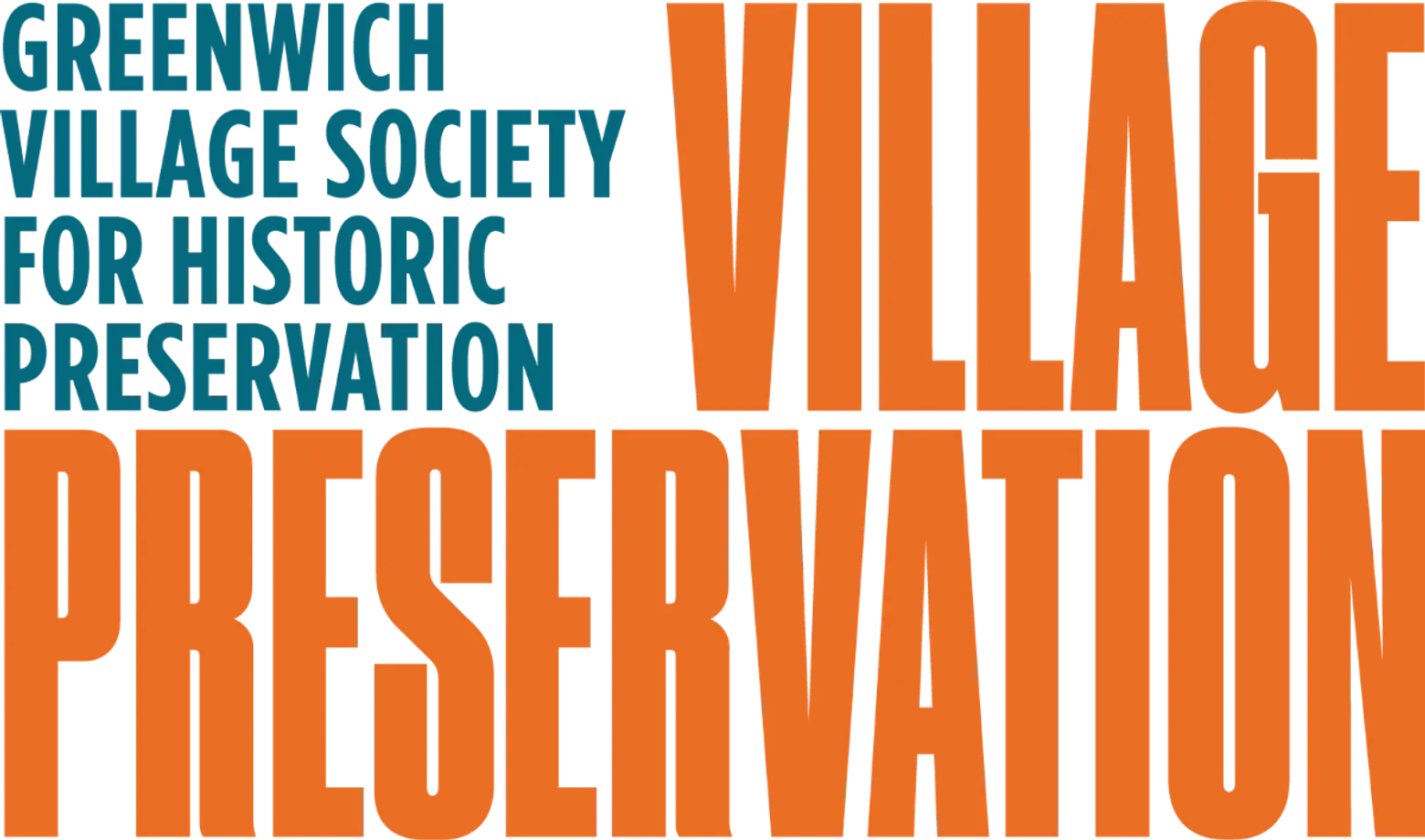
This post comes from Village Preservation. Since 1980, Village Preservation has been the community’s leading advocate for preserving the cultural and architectural heritage of Greenwich Village, the East Village, and Noho, working to prevent inappropriate development, expand landmark protection, and create programming for adults and children that promotes these neighborhoods’ unique historic features. Read more history pieces on their blog Off the Grid
